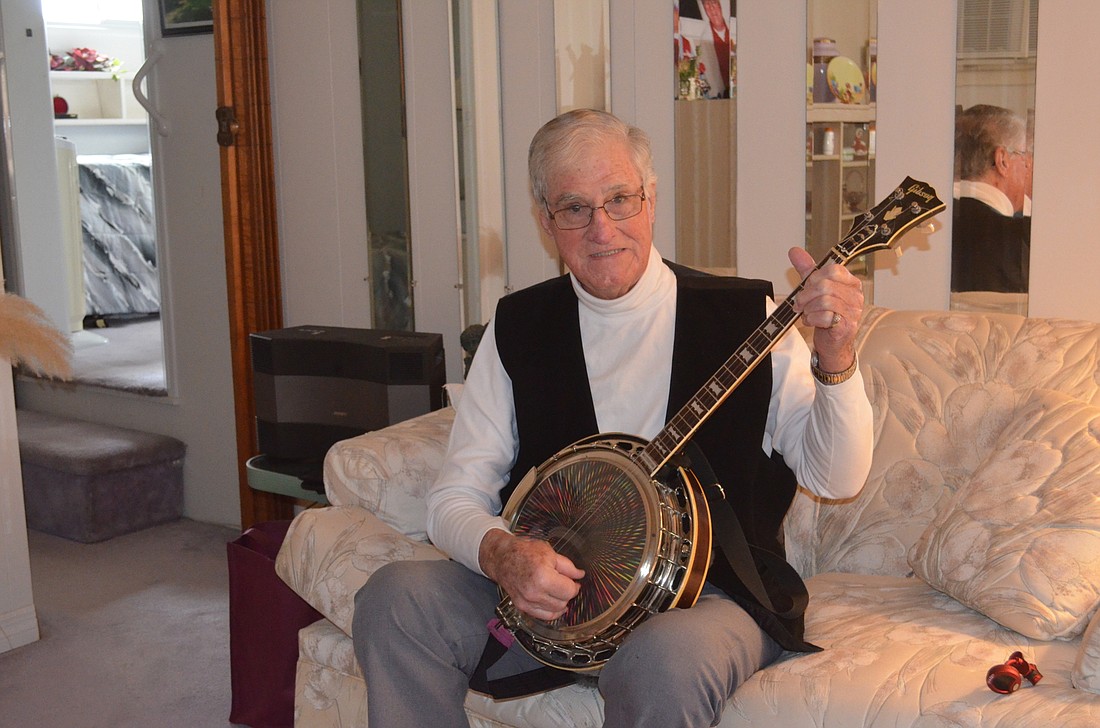- November 19, 2024
-
-
Loading

Loading

From the age of 14, Max Morrison never went anywhere without his banjo, even during World War II.
“Combat was no place for a banjo,” Morrison said. “I played one time. A cook was making coffee and asked me to play. It lasted five minutes before I froze. The banjo was put behind a driver’s seat in a truck, and I never saw it again.”
The truck the banjo was stored in struck a land mine, killing everyone inside.
In January 1945, Morrison was injured in the mountains of France when a German 88 shell hit him. His right hand and elbow were shattered, and his left arm was attached to his body by only the skin. His left arm was reattached, but he eventually lost his right index finger.
Despite his extensive injures, he was determined to pick up the banjo again at 22.
“In 1948, some people from the Army came to my bed and asked if I lost anything in combat other than photos,” Morrison said. “They bought me this Gibson banjo I still use right here. I decided to keep playing with my war injuries. Why not? My fingers still work.”
Relearning the banjo didn’t come without challenges.
“I couldn’t play because on my right hand, the pick wouldn’t fit and wouldn’t work right,” Morrison said. “An employee from General Motors came to me and said I used to play for dinner parties, and he asked why I’m not playing anymore. I told him about my pick problem, and he said he’d make me a pick I could use. He made me a wood one, didn’t work, a plastic one, didn’t work, and a metal one, didn’t work. He said ‘I have one more. We have hard rubber.’ It worked. He made me eight of those. I still use them. It’s the reason I play today.”
Morrison, who turned 90 last week, is known as “Mr. Banjo.” He first picked up the instrument almost 76 years ago, but the banjo wasn’t his first choice.
“I was in a church orchestra and started on guitar,” he said. “There were seven guitar players and one banjo player. No one paid attention to the guitars but everyone to the banjo. I said I was going to switch to banjo, so I did.”
Morrison spent the next four years playing the banjo at parties and gatherings in his home of Mansfield, Ohio. At 18, he was drafted to the Army in 1944.
After 17 weeks of basic training in Arkansas and Missouri, with his banjo in hand, Morrison was sent to Marseille, France.
Morrison became an intelligence scout in Gen. George Patton’s famous Third Army during the time of the Battle of the Bulge, when he was injured.
“I don’t know why I’m alive,” Morrison said. “I should have been dead. The temperature was 20 below zero, and that saved my life. I would’ve bled out if it was warmer.”
Morrison was rehabilitated in French, German and Moroccan hospitals for two years before being treated in Cleveland.
He was discharged in 1946 at 20 years old and received a Purple Heart.
When Morrison did pick up the banjo again in 1948, he found success throughout Ohio, and in the 1950s, he played in the Miss Ohio USA pageant three times.
“I got to play between bathing suits and gowns,” Morrison said. “One of my best memories. I played three encores, and Miss America Mary Ann Mobley asked me to go out and play for her one more time. I got a standing ovation with 1,400 people there.”
Since then, Morrison has played banjo at weddings, parties and other gatherings in both Mansfield and the Sarasota area. He bought his Twin Shores home with his wife, Mary, in 1972.
Morrison has no plans to slow down or stop playing at 90.
“My doctor said, ‘What the hell is your secret?’” Morrison said. “I’ve never smoked in my life, I walk, I ride my bike, I sleep 10 hours a night if I can. The doctor said I look 65. I’m OK with that.”